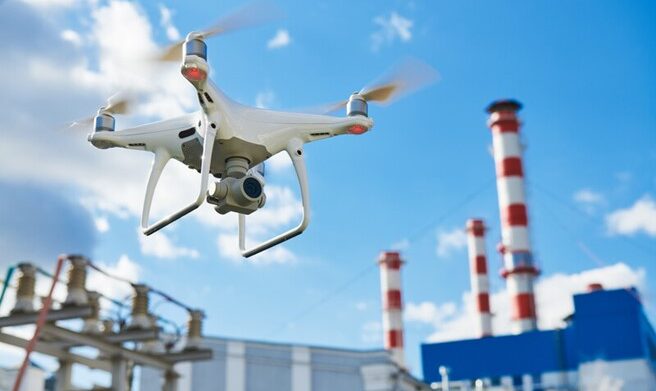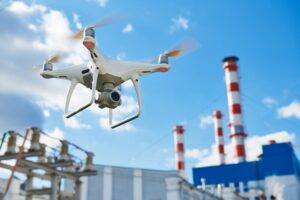Solutions for counter-drone operations across various use cases
“Technology offers us a unique set of opportunities and challenges; how we navigate them will determine our future.” — Satya Nadella, CEO of Microsoft
In today’s rapidly evolving world, few innovations have revolutionary potential like unmanned aerial systems, commonly known as drones. These flexible aerial vehicles have quickly become indispensable tools across a range of industries, enabling us to explore new frontiers, enhance efficiency and gather valuable geospatial data.
From aerial surveys and infrastructure inspections to search and rescue operations, drones have demonstrated their immense value and versatility whilst transforming various industries. Within defence there are recent examples of civilian drones being turned to military usage for reconnaissance and munitions delivery.
Geospatial applications
Consider the powerful applications of drones in the geospatial realm. In environmental conservation, they aid scientists in monitoring and protecting delicate ecosystems, allowing for more effective preservation strategies. In agriculture, drones equipped with advanced imaging technologies provide farmers with invaluable insights into crop health, enabling precise interventions and resource optimisation.
For disaster response, drones offer rapid situational awareness, helping emergency personnel assess affected areas and plan rescue operations efficiently. A drone does not need a runway and can be transported in a travel case, and thus is rapidly deployable.
The use of drones in the defence realm has been underway since the Vietnam War; it has only increased since then, particularly after 9/11. When combined with onboard video cameras, drones are excellent for surveillance.
Asset surveys of hard to access infrastructure, such as towers, roofs and ceilings, are now being carried out by drone.
These are just a few examples of how drones have unlocked new possibilities and increased the capabilities of geospatial professionals.
Mitigating risk
However, as with any technological advancement, the rise of drones also brings forth inherent threats and risks that demand attention. The very attributes that make drones so beneficial, such as their manoeuvrability, range and ease of operation, also make them potentially susceptible to misuse.
There is a growing list of instances where rogue drones have invaded restricted airspace, jeopardizing public safety, compromising sensitive information such as troop or asset locations and even posing risk to critical infrastructure, such as the recent attacks on oil refineries and buildings, many miles from the war zone. The rapid spread of drones, coupled with their swiftly evolving capabilities, calls for a proactive approach to mitigate these risks and safeguard the collective security of asset and people.
To fully leverage the immense potential of drones in the geospatial industry, there must be a delicate balance between embracing innovation and containing the risks. This requires developing robust frameworks and implementing effective countermeasures to prevent unauthorized drone activities, safeguard privacy and protect against potential malicious uses.
By proactively addressing the challenges and collaboratively navigating the opportunities presented by drone technology, we can ensure a future where the geospatial industry thrives while maintaining a secure and responsible environment.
A look into C-UAS
In this blog series, we will look into the world of counter-unmanned aircraft systems (C-UAS), exploring the diverse applications of drones, their associated threats and the imperative to contain these risks. We will examine the evolving landscape of C-UAS technologies and the integration of geospatial intelligence to enable effective and responsible use of drones, with a focus on the importance of 3D visualisation and artificial intelligence.
By understanding the opportunities and challenges that lie ahead, we can move towards a harmonious coexistence between drones, the many industries they support and other airspace users.
Threats and problematic behaviour of drones
Drones have become increasingly accessible, empowering individuals from various backgrounds to operate them. However, this accessibility also brings the potential for problematic behaviour that poses threats to society. In this blog, we will explore five types of problematic behaviour exhibited by drone pilots and provide clear examples of how they can undermine safety, privacy and security.
Careless behaviour
Careless drone pilots demonstrate a lack of regard for regulations and safety precautions. They may fly their drones in restricted airspace, close to people or sensitive infrastructure, without proper authorisation or understanding of the potential risks. One example is a drone pilot who carelessly operates a drone near an airport, disrupting air traffic and endangering the lives of passengers and crew.
Reckless behaviour
Reckless drone pilots exhibit a deliberate disregard for safety guidelines and regulations. They may perform aggressive manoeuvres, fly at excessive speeds or intentionally fly their drones in a manner that endangers others. An example of reckless behaviour is a drone pilot who flies a drone at high speeds through a crowded public event, risking collisions with attendees and causing panic.
Intrusive behaviour
Some drone pilots invade personal privacy by using drones to capture images or videos without consent or inappropriately accessing private property. For instance, a drone pilot might fly a drone near residential areas, peering into people’s homes or capturing intimate moments without permission, violating individuals’ privacy rights.
Malicious behaviour
Malicious drone pilots exploit drone technology for sinister purposes, such as conducting surveillance for illegal activities, smuggling contraband or conducting espionage. An example of malicious behaviour is a drone pilot using a drone to covertly capture sensitive information from corporate or government facilities for malicious intent or financial gain.
Disruptive behaviour
Disruptive drone pilots aim to cause disruptions or nuisances by intentionally interfering with public events, critical infrastructure or emergency response operations. This behaviour can disrupt public safety, communication networks or essential services. An example of disruptive behaviour is a drone pilot intentionally flying a drone near a wildfire, hindering firefighting efforts and putting lives and property at risk.
Responsible drone usage
It is important to note that not all drone pilots engage in problematic behaviour, and the vast majority of drone enthusiasts operate responsibly and lawfully. However, these examples highlight the potential risks associated with drone misuse and the need for robust regulations and countermeasures to address such behaviour.
The later entries of this blog series will explore the strategies, technologies and approaches to mitigate these threats and safeguard against problematic behaviour. By understanding the risks and taking proactive measures, we can promote responsible drone usage and ensure the safe integration of drones into our society.
While you wait for our second blog, which covers the data sources and core capabilities of geospatial C2 systems, check out this article on how countering UAS underscores the need for modern C6ISR capabilities.


















